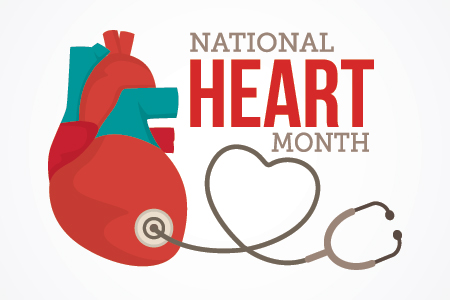 February marks American Heart Month — a campaign aimed at educating citizens about the importance of cardiovascular health. The National Heart, Lung, and Blood Institute (NHLBI) is encouraging visitors to their website to adopt heart-healthy behaviors through increasing exercise, as well as positive diet and lifestyle changes.
February marks American Heart Month — a campaign aimed at educating citizens about the importance of cardiovascular health. The National Heart, Lung, and Blood Institute (NHLBI) is encouraging visitors to their website to adopt heart-healthy behaviors through increasing exercise, as well as positive diet and lifestyle changes.
Why Heart Month?
Cardiovascular disease is the leading cause of death among both men and women globally, accounting for about 18.6 million deaths in 20181. However, reducing risk factors such as high blood pressure, high cholesterol, and smoking has been shown to decrease the risk for developing heart disease.Cardiovascular Disease, Heart Disease, and Coronary Heart Disease
Cardiovascular disease (CVD) is a general term that encompasses a multitude of heart and blood vessel-related conditions. However, it is not interchangeable with heart disease. Heart disease specifically refers to diseases that affect the heart's structure and function. The most common form of heart disease is coronary heart disease, also known as coronary artery disease, which results from a build-up of plaque in the arteries.Plaques can be composed of fat, cholesterol, calcium, cellular waste, and other substances found in the blood. When the arteries become severely clogged, the amount of oxygen-rich blood traveling to the heart is reduced, resulting in chest pain and shortness of breath. When plaques rupture they can cause blood clots, which are the most common cause for heart attacks2.
Hypertension and Cardiovascular Disease
The CDC's Division for Heart Disease and Stroke Prevention (DHDSP) is focusing on the role of hypertension (high blood pressure) on heart disease for American Heart Month in 2022. Hypertension increases the risk of both heart disease and stroke (two leading causes of death in the US) and served as a primary or contributing cause in over half a million deaths in the US in 20193.The DHDSP is encouraging people to keep their blood pressure within a healthy range through prudent lifestyle choices, like eating a diet rich in potassium and fiber, limiting salt and saturated fat intake, maintaining a healthy weight, engaging in regular physical activity, avoiding smoking, limiting alcohol consumption, and getting sufficient sleep nightly. Since high blood pressure typically has no symptoms — and is often referred to as a silent killer — the DHDSP also advises people to measure blood pressure regularly at home or during periodic physician's visits.
A blood pressure reading comprises two numbers that indicate the amount of pressure a person's blood exerts against the artery walls. Systolic blood pressure (the first number in the reading) measures the pressure that occurs when the heart is beating, while diastolic blood pressure (the second number) measures that pressure between heart beats.
Although it's prudent to keep both numbers in a healthy range, an increase in systolic pressure is viewed as an especially significant risk factor for cardiovascular disease in people over the age of 504. Systolic pressure tends to increase with age as large arteries grow stiffer and more arterial plaque builds up. The higher incidence of cardiac and vascular disease in older populations also makes high systolic pressure a greater risk for those over 50.
Exercise is the Best Solution
Studies have shown that a regular program of physical activity can reduce the risk factors associated with CVD5. Additionally, increased levels of physical activity are correlated with a decrease in the risk for heart failure and an increase in the survival rate of those with coronary artery disease6.The Heart Truth® program, along with the NHLBI, are both recommending that Americans exercise for at least 150 minutes (2 ½ hours) per week. The level of exercise is defined as "enough to leave you a little breathless" and can be broken up into smaller amounts of time in order to better incorporate into your daily schedule. "Even small amounts add up and can have lasting heart health benefits," according to the NHLBI7.
















.jpg)

.jpg)
.jpg)
.jpg)
.jpg)





.jpg)


.jpg)
.jpg)

.jpg)


.jpg)





.jpg)

.jpg)



